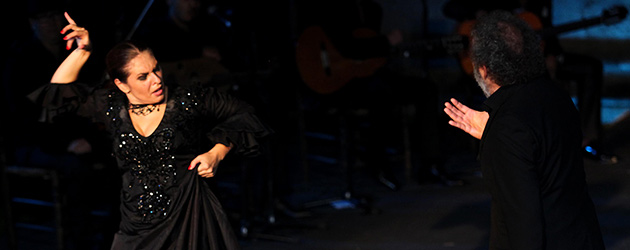Text: Sara Arguijo
Photos: Antonio Acedo
Debut of «Moratana» of Pastora Galván at the series Septiembre es Flamenco in Sevilla. Torre Don Fadrique Sevilla .
Wednesday, September 9th
The venue invited you to stroll through narrow and forgotten Arabic streets such as those whose images were projected onto the imposing Torre de Don Fadrique. The music evoked the history of communal living between gypsies and Arabs, and their parallelism in suffering as well as in optimism. And Pastora Galván herself, vehement, enigmatic and powerful, pushed us along for all the flamenco-Andalusi references, from the tangos Alquivira of Lole and Manuel – this time sung by her sister Angelita Montoya – Dame la Libertad of Juan Peña El Lebrijano, the pioneer in these experiments, and present in the audience.
Moratana is an attractive and ambitious work with all the ingredients to be effective. With good stage and musical direction, a first-class bill of artists and a dancer who knows how to show off the entire palette of colors and blend together the roots of two ancestral cultures with a single movement of her hips, without losing one whit of her personality.
Nevertheless, the show didn't come together. The theme of the work did little more than limit Galván's dancing instead of giving her the freedom in which she shines. Of course expectations were high, and we expect only the best from this artist, but it was difficult to follow the pace of the show and, on occasion, we missed being able to detach ourselves from the circumstantial elements in order to be carried along by the depth and strength of the defiant Pastora.
Of course, there were moments of great beauty such as the Zambra of the Alhambra in which she was carried away by the penetrating voice of Juan José Amador. The fandango danced to tambourinne. The Vito, interpreted along with Rubén Olmo, in which both laid out the infinite possibilities the Seville woman finds in everything that smells of folklore. Or the dark taranto that was, without a doubt, the most flamenco moment of the night.
And Pastora found moments to move the shawl, curve her back, play the castanets, rock her body and show her natural artistry, the ease at being on stage and the daring personality that places her at the top. But maybe we've become so accustomed to enjoying her dancing, that we now have a hard time accepting her in a different context that is not her own character.
